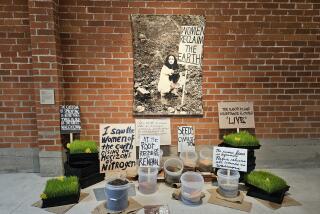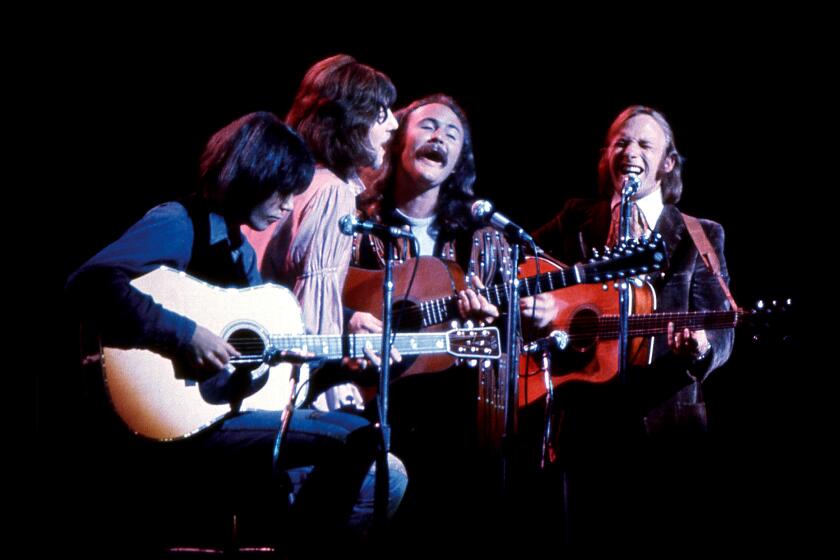Georgia O’Keeffe: A Landscape With Words...
- Share via
“Words and I are not good friends at all,” Georgia O’Keeffe wrote to Alfred Stieglitz in 1916. But she could paint gloriously, so what did words matter? With great confidence in her art, she ignored the critics who misunderstood her work and wrote little for publication. Characterized first as a naive, self-taught painter and later as a stern, enigmatic recluse, she did little to alter her public image. Indeed, through her silence, she seemed to guard and nurture the myths that grew up around her as one of the great American artists of this century.
Now, in “Georgia O’Keeffe: Art and Letters,” a handsome catalogue accompanying the centennial exhibition of O’Keeffe’s work at the National Gallery of Art, the painter speaks. And in the well-edited selection of personal letters that form the core of the book, O’Keeffe emerges as an even more complex and passionate person than she herself was willing to reveal before her death in 1986.
O’Keeffe’s writing is like her painting: direct, spare, energetic, and rendered in an idiosyncratic style that defies conventional rules. The punctuation consists mainly of dashes. Sentences are composed of fragmented thoughts or impressions layered on top of each other to convey an idea or experience. There is a kind of assumption implicit in the writing (as in the painting) that whatever she says will be of interest.
O’Keeffe emerges here as a woman of contradictions. She purports to be unconcerned about public criticism of her work but, in fact, seems to take to bed with a kind of nervous exhaustion whenever her work is exhibited. She accepts without public comment the reviews that characterize her as “some strange unearthly sort of creature floating in the air” when the truth is, she writes a friend, “that I like beef steak--and I like it rare at that.”
While reviewers of her early shows tended to speak of O’Keeffe as a purely intuitive painter, these letters reveal that she was actively engaged in the intellectual and cultural movements of the times. She read the art journals Camera Work and 291, read widely in art theory, and attended concerts, art exhibitions, and lectures on suffrage. “I may seem very free,” she wrote a friend in 1930, “a cross between a petted baby and a well-fed cow--but I know a few things.”
In 1924, O’Keeffe married Alfred Stieglitz, the leading proponent of American modernism, who had first shown her work at his New York gallery in 1917. Stieglitz was 23 years her elder, and if his extraordinary photographs of O’Keeffe suggest the passion of their relationship, O’Keeffe’s letters reveal the strains and conflicts. She was at once the care-giver and the one who was cared for; a strong independent woman and a dutiful protege. Stieglitz seems “a forlorn little soul,” she wrote to author Sherwood Anderson in 1924, “I do what I can.” But two years later, she confessed to a friend, “I feel like a little plant that he has watered and weeded and dug around.”
Particularly after 1929 when she discovered New Mexico, a place that Stieglitz refused to visit, O’Keeffe felt torn. In 1932, she wrote, “I am divided between my man and a life with him--and some thing of the outdoors . . . I have to get along with my divided self the best way I can.” She did it by spending part of each year with Stieglitz in New York and part of the year alone in New Mexico painting the color-streaked cliffs and bleached desert bones she had grown to love.
With Stieglitz’s death in 1946, the conflict was resolved, and O’Keeffe seemed to develop a more independent, self-confident sense of self. “It is as if I feel my world is a rock,” she wrote to a friend in 1950, describing how a prominent priest had attempted to convert her to Catholicism. “I was amazed that he could only make the Catholic Church seem like a mound of jelly compared to my rock.”
Despite her public image of reserve, O’Keeffe emerges in these letters to her friends as a passionate woman. She writes with exhilaration of the vastness of the West Texas plains, the brilliance of a sunset, the smell of damp sage, the challenge of trying to convey in paint here “experience” of a flower. She is finely attuned to sensate imagery. “Color is one of the things in the world that makes life worth living to me,” she asserts.
We learn much about O’Keeffe from the letters in this new book, but much remains unsaid and unknown. In a letter published here from 1948, O’Keeffe alludes to the letters she wrote to Stieglitz during her many months in New Mexico. Yet none appears here. Indeed, a major collection of O’Keeffe/Stieglitz correspondence remains inaccessible at the Beinecke Library at Yale until 25 years after O’Keeffe’s death. Moreover Juan Hamilton, O’Keeffe’s close companion from 1973 until her death and an active protector of the O’Keeffe image, is a collaborator in this new publication. One can’t help but wonder, despite all the new information presented here, how much he continues to shape and control what we know of O’Keeffe.
The second major book published on the occasion of the centennial of O’Keeffe’s birth is a different sort of enterprise entirely from the thoughtful, restrained publication assembled by the National Gallery. “Georgia O’Keeffe: One Hundred Flowers” is a lavish, extravagant book, 13 3/8 x 16 inches, with beautifully printed reproductions of O’Keeffe’s flower paintings exploding off the pages. It is a flashy undertaking, with none of the quiet elegance that marks the National Gallery book or the books on Stieglitz and O’Keeffe that O’Keeffe herself oversaw. The text is minimal: a brief afterword by the book’s editor and publisher Nicholas Callaway, detailed notes on the reproductions, and an elaborate colophon page.
The lavish presentation of the book and the minimal text seem to beg for review on the grounds of style and design. And sadly, despite the fine reproductions, on these terms, the book is a disappointment. All of the images are reproduced in their entirety, but they run across gutters, bleed off the page on two edges, or sometimes three or four. It is fascinating to see several paintings of a single flower reproduced together. But the reproductions have no captions (for that one must turn to the back of the book), and it is hard to follow O’Keeffe’s development of an idea when one has no easy access to the dates, size or medium of a given image.
The publication might be merely a triumph of decorative bookmaking, but the power of O’Keeffe’s art refuses to be dimmed. Her monumental flower paintings shocked the viewers who first saw them in the 1920s. One reviewer wrote that confronting the large canvases made the viewer feel “as if we humans were butterflies.” The paintings retain that power today, and the substance of O’Keeffe’s art triumphs here over awkward presentation.
More to Read
The biggest entertainment stories
Get our big stories about Hollywood, film, television, music, arts, culture and more right in your inbox as soon as they publish.
You may occasionally receive promotional content from the Los Angeles Times.










